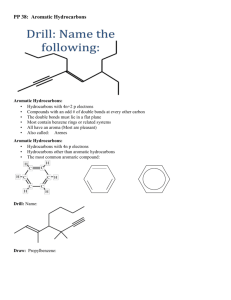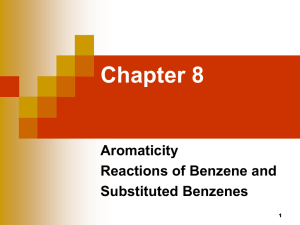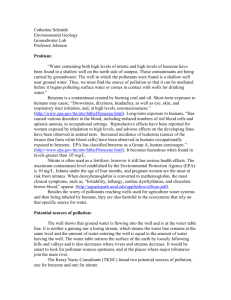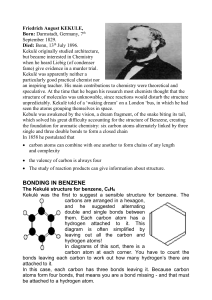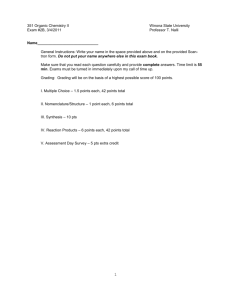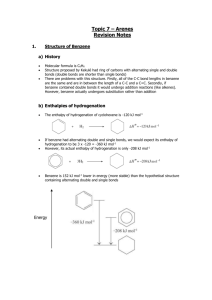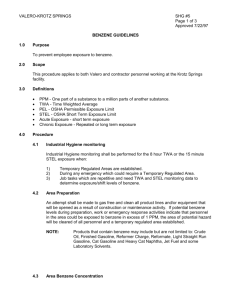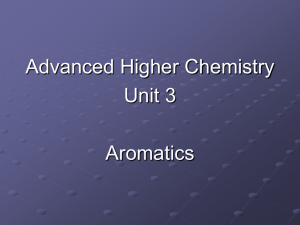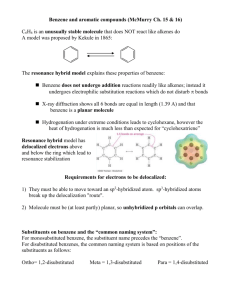Carey Chapter 11 Arenes And Aromaticity
advertisement
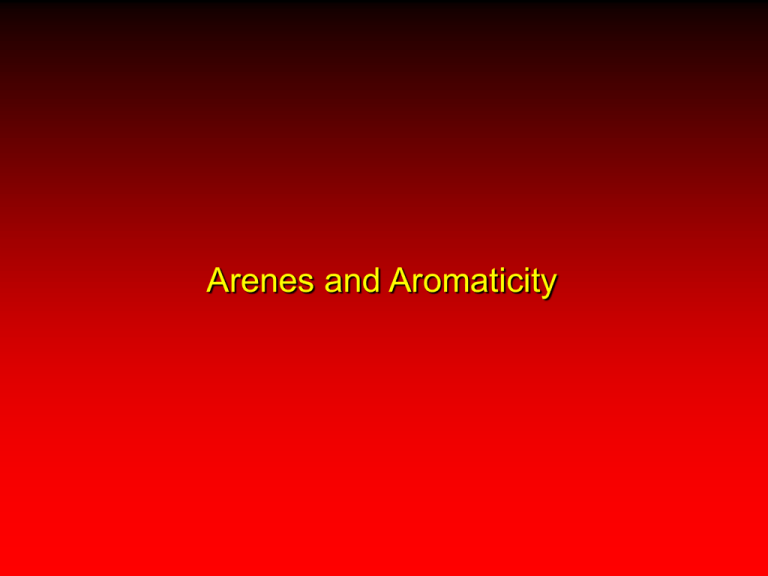
Arenes and Aromaticity Hydrocarbons Aliphatic Alkanes Aromatic Alkenes Alkynes Examples of Aromatic Hydrocarbons CH3 H H H H H H H H H H H Benzene H H Toluene H H H H H H Naphthalene Some history 1834 Eilhardt Mitscherlich isolates a new hydrocarbon and determines its empirical formula to be CnHn. Compound comes to be called benzene. 1845 August W. von Hofmann isolates benzene from coal tar. 1866 August Kekulé proposes structure of benzene. Kekulé Formulation of Benzene Later, Kekulé revised his proposal by suggesting a rapid equilibrium between two equivalent structures. H H H H H H H H H H H H Structure of Benzene Structural studies of benzene do not support the Kekulé formulation. Instead of alternating single and double bonds, all of the C—C bonds are the same length. Benzene has the shape of a regular hexagon. Resonance Formulation of Benzene Circle-in-a-ring notation stands for resonance description of benzene (hybrid of two Kekulé structures) Orbital Hybridization Model of Bonding in Benzene High electron density above and below plane of ring Hückel's Rule among planar, monocyclic, completely conjugated polyenes, only those with 4n + 2 p electrons possess special stability (are aromatic) n 4n+2 0 2 1 6 2 10 3 14 4 18 General Points 1) Benzene is considered as the parent and comes last in the name. 2) List substituents in alphabetical order 3) Number ring in direction that gives lowest locant at first point of difference Example Cl Br F 2-bromo-1-chloro-4-fluorobenzene Ortho, Meta, and Para alternative locants for disubstituted derivatives of benzene 1,2 = ortho (abbreviated o-) 1,3 = meta (abbreviated m-) 1,4 = para (abbreviated p-) Naphthalene resonance energy = 255 kJ/mol most stable Lewis structure; both rings correspond to Kekulé benzene Anthracene and Phenanthrene Anthracene Phenanthrene resonance energy: 347 kJ/mol 381 kJ/mol Reactions of Arenes: Electrophilic Aromatic Substitution H d+ +E d– Y E +H Y Representative Electrophilic Aromatic Substitution Reactions of Benzene H d+ +E d– Y E +H Y H d+ +E d– E Y +H Electrophilic aromatic substitutions include: Nitration Sulfonation Halogenation Friedel-Crafts Alkylation Friedel-Crafts Acylation Y Nitration of Benzene H + HONO2 H2SO4 NO2 + H2O Nitrobenzene (95%) Sulfonation of Benzene H heat + HOSO2OH SO2OH + H2O Benzenesulfonic acid (100%) Halogenation of Benzene H + Br2 FeBr3 Br + HBr Bromobenzene (65-75%) Friedel-Crafts Alkylation of Benzene H + (CH3)3CCl AlCl3 C(CH3)3 + HCl tert-Butylbenzene (60%) Friedel-Crafts Acylation of Benzene O O H AlCl3 + CH3CH2CCl CCH2CH3 + HCl 1-Phenyl-1-propanone (88%)



